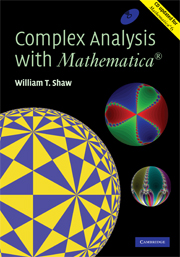Book contents
- Frontmatter
- Contents
- Preface
- 1 Why you need complex numbers
- 2 Complex algebra and geometry
- 3 Cubics, quartics and visualization of complex roots
- 4 Newton—Raphson iteration and complex fractals
- 5 A complex view of the real logistic map
- 6 The Mandelbrot set
- 7 Symmetric chaos in the complex plane
- 8 Complex functions
- 9 Sequences, series and power series
- 10 Complex differentiation
- 11 Paths and complex integration
- 12 Cauchy's theorem
- 13 Cauchy's integral formula and its remarkable consequences
- 14 Laurent series, zeroes, singularities and residues
- 15 Residue calculus: integration, summation and the argument principle
- 16 Conformal mapping I: simple mappings and Möbius transforms
- 17 Fourier transforms
- 18 Laplace transforms
- 19 Elementary applications to two-dimensional physics
- 20 Numerical transform techniques
- 21 Conformal mapping II: the Schwarz—Christoffel mapping
- 22 Tiling the Euclidean and hyperbolic planes
- 23 Physics in three and four dimensions I
- 24 Physics in three and four dimensions II
- Bibliograpy
- Index
22 - Tiling the Euclidean and hyperbolic planes
Published online by Cambridge University Press: 05 August 2014
- Frontmatter
- Contents
- Preface
- 1 Why you need complex numbers
- 2 Complex algebra and geometry
- 3 Cubics, quartics and visualization of complex roots
- 4 Newton—Raphson iteration and complex fractals
- 5 A complex view of the real logistic map
- 6 The Mandelbrot set
- 7 Symmetric chaos in the complex plane
- 8 Complex functions
- 9 Sequences, series and power series
- 10 Complex differentiation
- 11 Paths and complex integration
- 12 Cauchy's theorem
- 13 Cauchy's integral formula and its remarkable consequences
- 14 Laurent series, zeroes, singularities and residues
- 15 Residue calculus: integration, summation and the argument principle
- 16 Conformal mapping I: simple mappings and Möbius transforms
- 17 Fourier transforms
- 18 Laplace transforms
- 19 Elementary applications to two-dimensional physics
- 20 Numerical transform techniques
- 21 Conformal mapping II: the Schwarz—Christoffel mapping
- 22 Tiling the Euclidean and hyperbolic planes
- 23 Physics in three and four dimensions I
- 24 Physics in three and four dimensions II
- Bibliograpy
- Index
Summary
Introduction
In our studies so far we have been concerned with the complex plane interpreted as a two-dimensional Euclidean plane – when the concept of distance has been needed, it has always been the standard Euclidean notion expressed by Pythagoras' theorem. There are concepts of distance other than the standard Euclidean one. Indeed, this notion is at the heart of modern geometrical physics, and finds expression in both the non-positive-definite notions of distance of special relativity, and the non-flat metrics of general relativity.
In this chapter we shall meet the hyperbolic plane, which is perhaps the simplest non-Euclidean geometry. We shall not be able, in one chapter, to do full justice to this concept – indeed, excellent entire books have already been written about it (Coxeter, 1965; Stahl, 1993). What we shall do is explore a little of the geometry through the process of tiling the hyperbolic plane (see the Bibliography for papers by Coxeter and Levy on this particular matter also).
This chapter is based substantially (the sections on triangles and the ‘ghosts and birdies’ tiling) on a project carried out by a former colleague, V. Thomas, for the BBC Open University Production Centre. Gratitude is expressed to A.M. Gallen and, latterly, the Open University for permission to use this material, to Professor R. Penrose F.R.S. (‘R. Penrose’ for short) for several helpful suggestions, and to V.
- Type
- Chapter
- Information
- Complex Analysis with MATHEMATICA® , pp. 473 - 512Publisher: Cambridge University PressPrint publication year: 2006



